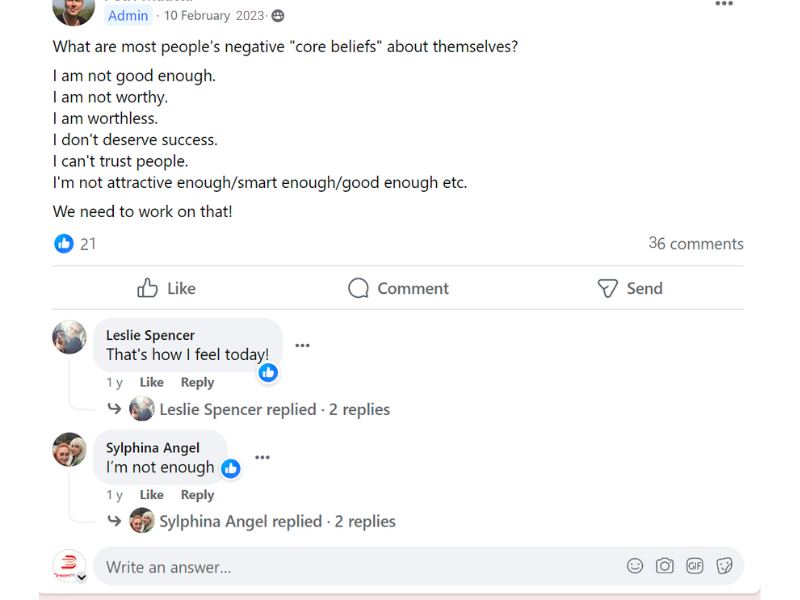On this page

Self-Limiting Beliefs: 4 Exciting Ways to Overcome Their Impact In Your Life
Explore what self-limiting beliefs are and how to overcome their impact on your life. Plus, 4 methods on identifying, questioning, and replacing negative thoughts with positive affirmations, including a ‘identifying your #1 self-limiting belief technique.
Did you know: We absorb all the beliefs of influential people in our formative years from 0-7.
- Some of these beliefs are loving and supportive
- Other beliefs may be self-limiting
- These beliefs, self-limiting or not, shape who we become as adults
- Most often, self-limiting beliefs interfere with our ability to reach our full potential
Self-limiting beliefs can form a defence mechanism against future pain.
We then construct distorted generalisations about life based on these encounters.
This makes us unable to create outcomes that match our wants.
In this article, we will explore four methods of overcoming self-limiting beliefs.
What Exactly Are Self-Limiting Beliefs?

Self-limiting beliefs are barriers that can prevent people from reaching their full potential.
Vygotsky’s hypothesis of child development suggests that children benefit greatly from the guidance of someone knowledgeable within their community, be it a parent or a teacher.
But what if the parent or teacher imposes their limiting beliefs on the children?
For example:
If a father tells (shouts) his child:
- “We can’t afford this?”
- “Do you think money grows on trees?”
The father is correct in not spending money on what he considers to be [ultra-luxury, over-priced, shitty ‘brand’] shoes when other, less expensive shoes are adequate for the purpose.
But the limiting belief instilled in the child can wreak havoc on the child’s self-image and self-worth.
The child gets the point, hm, “Sounds to me like money causes Daddy a lot of pain, better not to ask for money, ever again, so we can avoid that pain!!!”
The worst part is that these generalisations become embedded in our subconscious mind.
So they manifest as limiting beliefs.
Limiting beliefs that say: “There is not enough money to go around, so stop asking for more before something bad happens to you”.
Addressing self-limiting beliefs
Recognizing and understanding self limiting beliefs is the step towards addressing them.
These beliefs can stem from experiences, societal norms or negative self-talk creating a narrative that influences how our thoughts create our reality.
Once we identify these beliefs, we can use strategies to break free from their limitations.
The process involves questioning and reframing our beliefs, and building a more positive mindset.
We do that by actively taking steps to adopt new, empowering beliefs.
But first…
Step 1#: Identify Your Limiting Beliefs
To overcome self-limiting beliefs, it is important to start by identifying them.
It involves introspection and recognizing any recurring patterns that may be hindering your progress.
Become Self-Aware
Developing self awareness people to observe their deep thoughts and behaviours from a new perspective. Through mindfulness practices one can distinguish between realities and the restrictions they impose on themselves.
It may be helpful to ask yourself questions such as:
“What beliefs do I hold regarding my abilities?”
Identifying and Acknowledging Self-Limiting Beliefs:
The initial step in overcoming self-limiting beliefs is accepting their existence. In many cases, these beliefs are inner voices that prey on confidence or instil self-doubt.
When these thoughts are actively recognized, people can begin to tear down the building blocks of their self-limiting beliefs.

Journaling and Self-Reflection
Another popular method for introspection is journaling. When a person writes down their innermost thoughts on prompted topics, it may reveal hidden blocks. They may also come to understand themselves better. What their limiting beliefs are, what triggers these beliefs, and how these beliefs affect their life and outcomes.
- Journaling and self-reflection facilitate each other because they allow people to find points of connection between their thinking, feelings, and actions.
- Self-awareness in this sense is being able to identify the triggers that lead to self-limiting beliefs.
- They can be either external, particular situations or individuals trigger them; internal ones are caused by emotions, previous events or memories.
Self-reflection enables people to challenge and reconsider these beliefs.
Identifying your #1 self-limiting belief technique
Identifying your #1 self-limiting belief is a technique that revolves around your personal story.
It’s the story you’ve been told all your life, through your parents, the schooling system and television programming.
The story is based around programming of how things should work in your life.
So, you keep telling the same story over and over again.
- I should earn $100.000/year
- I must work for money
- I must drive a specific car
- I must be a good parent
- I must be in a specific way in a relationship
Reflecting on one’s personal narrative involves looking back at key life events and the stories they tell themselves about these events.
That’s how your beliefs are born.
To identify your #1 limiting belief, start by writing the story of money.
How much have you been programmed to believe that you must earn?
The answer to this will give you a clear idea about your personal limiting belief about how much money can come into your life.
While this is true, you can also adopt new beliefs that can help you make changes in your life.
You do this by adopting what is called a Growth mindset.
Step 2#: Adopting a Growth Mindset

Embracing a growth mindset plays a role in how to overcome your limiting beliefs.
Growth mindset revolves not only around a positive mental attitude. It means that our abilities and intelligence can be nurtured. Which then motivates us to confront negativity, prioritize learning and cultivate resilience.
Embracing Learning
It’s important for individuals to realize that every experience, whether it leads to success or failure presents an opportunity for growth and learning.
One way to begin is by dedicating time for self improvement actively seeking out knowledge and skills that align with their goals. If a person fear of failure, they should prioritize the process of learning to feel more confident
Strategy 1: Balancing Learning and Performance Goals
In addition to setting performance goals individuals should also set learning goals. This ensures that personal development remains an aspect alongside achieving desired outcomes.
Strategy 2: Reflecting on Daily Experiences for Insights
Taking the time to reflect on experiences can provide lessons. By extracting insights from these experiences individuals can gain an understanding of themselves. Grow even further.
Celebrate The “Small Wins”
Recognizing and appreciating achievements is essential as they serve as stones towards larger aspirations. These moments reinforce the growth mindset by demonstrating progress in development. Keeping a journal to document these milestones or sharing successes with a community can be highly motivating.
Achievement Log: Keep track of each milestone regardless of its size along with dates.
Recognition: Take the time to celebrate these achievements as it enhances motivation and encourages growth.
Step 3#: Implement Practical Strategies

To overcome self imposed limitations it is important to integrate steps into our routine. There are two strategies that can help in this regard; setting goals and cultivating a supportive network.
Setting Realistic Goals
A part of the process is to identify and set goals that are realistic, not dreams.
These goals should be specific, measurable, attainable, relevant and time bound ( referred to as SMART goals).
For example, aiming to “become more confident ” one could set a goal to “actively participate in at least one discussion during every meeting, for the next month.”
Building Support Networks
Creating a support system can greatly strengthen our ability to combat self limiting beliefs. This involves surrounding ourselves with individuals who offer feedback and motivation. Actively seeking mentorship or becoming part of peer groups can significantly enhance our progress.
And to help us stay focused on our objectives.
Step 4#: Maintaining Progress and Resilience

Overcoming self imposed limitations is a journey, than a single moment demanding a consistent commitment and the flexibility to adjust. Individuals need to monitor their growth and be open to refining their approaches ensuring advancement and resilience.
Evaluating Progress
Evaluating thought patterns and behaviors is crucial in recognizing transformations. Maintaining a journal that records instances of self doubt along with instances of challenging these limiting beliefs to embrace changes in your life. Creating a table can be effective, for this purpose:
| Date | Self-Limiting Belief | Challenging Action Taken |
| 01/02/2024 | “I’m not qualified to lead.” | Volunteered to head a project |
| 15/02/2024 | “I can’t handle criticism.” | Requested feedback on work |
Through consistent logging, individuals can visibly witness their growth over time, creating resilience and motivation to continue.
Adjusting Tactics as Needed
If someone discovers that their current strategies are not producing the desired outcomes, it is essential for them to adjust their approach accordingly. This could involve seeking additional resources like Harvard Business Review for insights, on dealing with self imposed limitations. Alternatively, one could explore exercises or seek guidance from a mentor to receive personalized advice. This ability to adapt and change tactics demonstrates resilience.
Frequently Asked Questions
In this Faq section, we answer some of the key questions about self-limiting beliefs,how to identify them, and strategies for overcoming them.
What are the most common limiting beliefs?
People often hold onto self limiting beliefs like “I lack competence” “I won’t succeed in business without an MBA “. “It’s too late for me to embark on a new career.”
These beliefs can really impede growth and fulfillment.
What methods can be used to identify personal limiting beliefs?
To identify these limiting beliefs within ourselves we can start by engaging in self reflection and journaling. It’s also helpful to pay attention to feedback from others and recognize any recurring self-talk. Taking inspiration from Tony Robbins guide, on conquering limiting beliefs there are tools and exercises that offer a systematic approach.
Which exercises are effective for overcoming limiting beliefs?
To overcome beliefs that hold us back there are exercises we can try. Behavioral therapy techniques, visualization and gradually facing our fears are all approaches. Additionally, asking ourselves challenging questions can be a tool in shifting our mindset.
Can affirmations help in combating self-limiting beliefs, and how should they be used?
Absolutely, using positive affirmations consistently works very well. With confidence can effectively combat self limiting beliefs. It’s important to ensure that these affirmations focus on the individual’s abilities and are expressed in the tense to create a sense of urgency and authenticity.
What is the psychological basis behind limiting beliefs and how can understanding it help?
Many times, our beliefs that hold us back stem from thinking patterns. Cognitive behavioral therapy can help us address this. Overcome these limiting beliefs by exploring their origins. By gaining an understanding of the foundation behind these thought patterns we can empower ourselves to break free from them and reshape our mindset in a more positive way.
What role does coaching play in addressing and transforming self-limiting beliefs?
Coaching is extremely important because it provides guidance, accountability and support. A coach assists individuals in identifying and questioning their limiting beliefs, which allows for the development of beliefs that create personal growth and achievement.
Related:

Petri Maatta is a mindset coach and neuroscience-focused author with 15 years of experience in personal transformation and success psychology. After seven years of business failures, he discovered the power of manifestation through a Fortune 500 mentor. Now, he shares neuroscience-backed strategies through DreamMaker membership, helping others transform their businesses and lives on their own terms.
Read My Story here.
Share This Story, Choose Your Platform!
You want to manifest a new car, but you’re wondering: Does this really work? Here’s
Many smart individuals are often linked with having a high IQ. However, according to emotional
According to online dating statistics over 90% of people believe in love at first sight,




